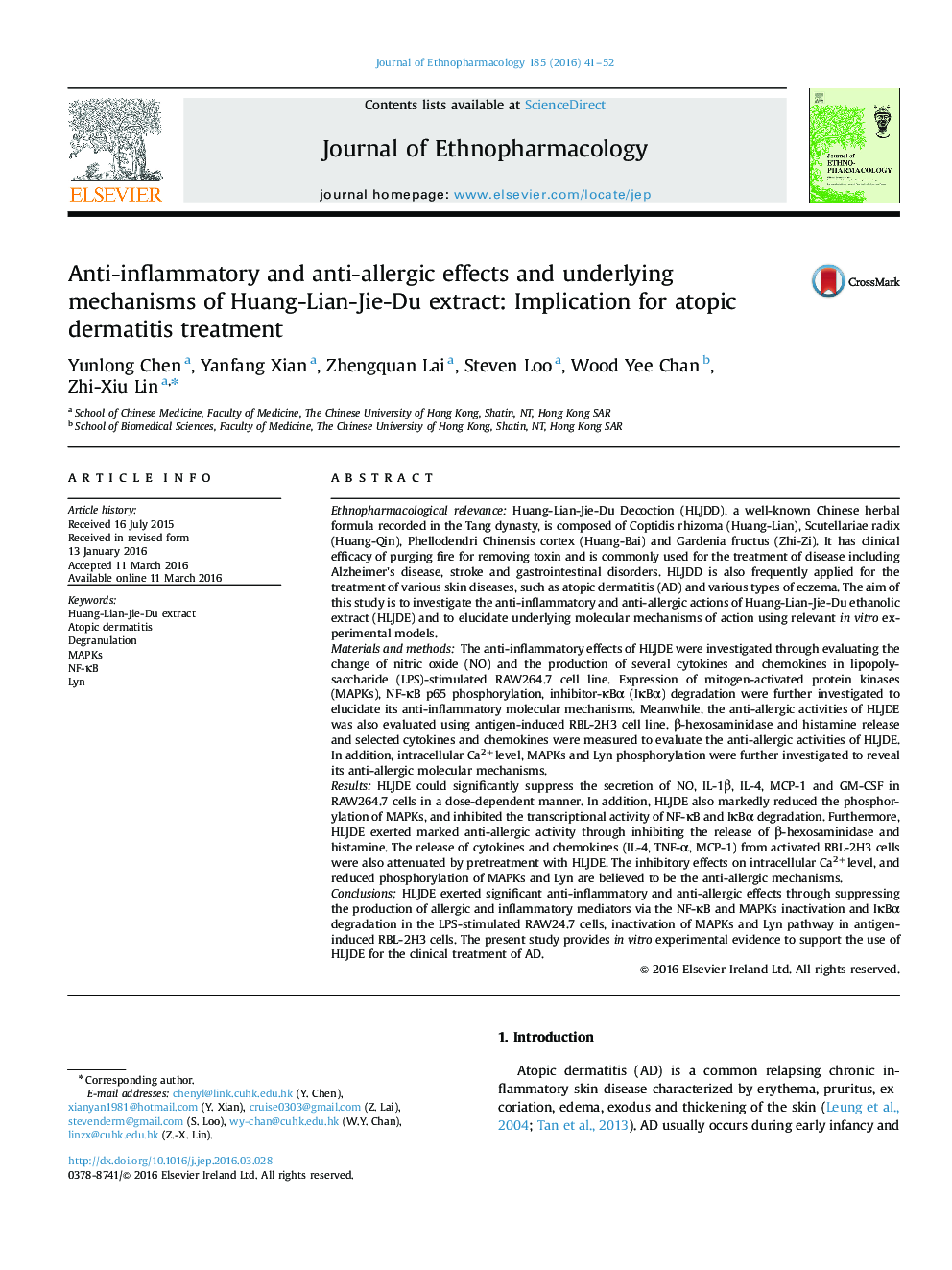| کد مقاله | کد نشریه | سال انتشار | مقاله انگلیسی | نسخه تمام متن |
|---|---|---|---|---|
| 2544825 | 1560377 | 2016 | 12 صفحه PDF | دانلود رایگان |
Ethnopharmacological relevanceHuang-Lian-Jie-Du Decoction (HLJDD), a well-known Chinese herbal formula recorded in the Tang dynasty, is composed of Coptidis rhizoma (Huang-Lian), Scutellariae radix (Huang-Qin), Phellodendri Chinensis cortex (Huang-Bai) and Gardenia fructus (Zhi-Zi). It has clinical efficacy of purging fire for removing toxin and is commonly used for the treatment of disease including Alzheimer's disease, stroke and gastrointestinal disorders. HLJDD is also frequently applied for the treatment of various skin diseases, such as atopic dermatitis (AD) and various types of eczema. The aim of this study is to investigate the anti-inflammatory and anti-allergic actions of Huang-Lian-Jie-Du ethanolic extract (HLJDE) and to elucidate underlying molecular mechanisms of action using relevant in vitro experimental models.Materials and methodsThe anti-inflammatory effects of HLJDE were investigated through evaluating the change of nitric oxide (NO) and the production of several cytokines and chemokines in lipopolysaccharide (LPS)-stimulated RAW264.7 cell line. Expression of mitogen-activated protein kinases (MAPKs), NF-κB p65 phosphorylation, inhibitor-κBα (IκBα) degradation were further investigated to elucidate its anti-inflammatory molecular mechanisms. Meanwhile, the anti-allergic activities of HLJDE was also evaluated using antigen-induced RBL-2H3 cell line. β-hexosaminidase and histamine release and selected cytokines and chemokines were measured to evaluate the anti-allergic activities of HLJDE. In addition, intracellular Ca2+level, MAPKs and Lyn phosphorylation were further investigated to reveal its anti-allergic molecular mechanisms.ResultsHLJDE could significantly suppress the secretion of NO, IL-1β, IL-4, MCP-1 and GM-CSF in RAW264.7 cells in a dose-dependent manner. In addition, HLJDE also markedly reduced the phosphorylation of MAPKs, and inhibited the transcriptional activity of NF-κB and IκBα degradation. Furthermore, HLJDE exerted marked anti-allergic activity through inhibiting the release of β-hexosaminidase and histamine. The release of cytokines and chemokines (IL-4, TNF-α, MCP-1) from activated RBL-2H3 cells were also attenuated by pretreatment with HLJDE. The inhibitory effects on intracellular Ca2+level, and reduced phosphorylation of MAPKs and Lyn are believed to be the anti-allergic mechanisms.ConclusionsHLJDE exerted significant anti-inflammatory and anti-allergic effects through suppressing the production of allergic and inflammatory mediators via the NF-κB and MAPKs inactivation and IκBα degradation in the LPS-stimulated RAW24.7 cells, inactivation of MAPKs and Lyn pathway in antigen-induced RBL-2H3 cells. The present study provides in vitro experimental evidence to support the use of HLJDE for the clinical treatment of AD.
Figure optionsDownload high-quality image (124 K)Download as PowerPoint slide
Journal: Journal of Ethnopharmacology - Volume 185, 5 June 2016, Pages 41–52
